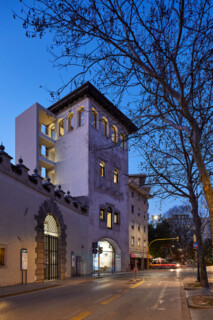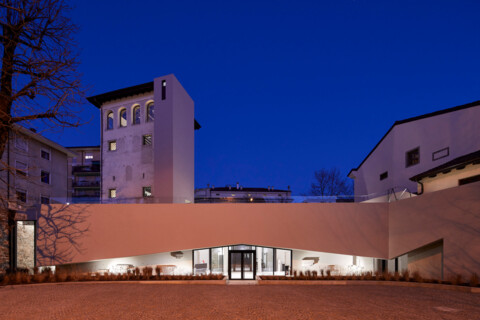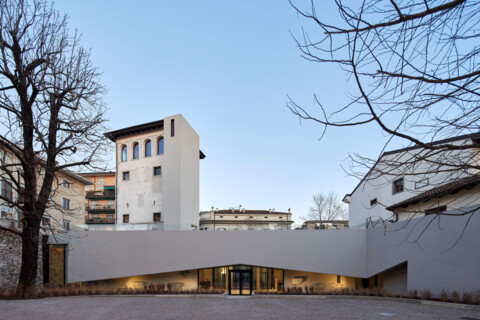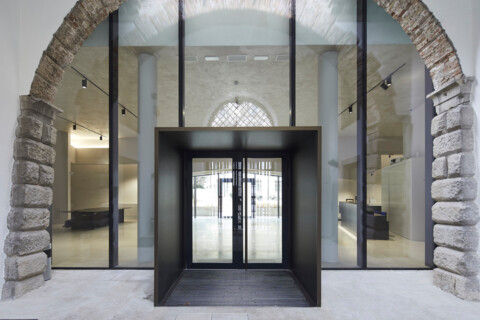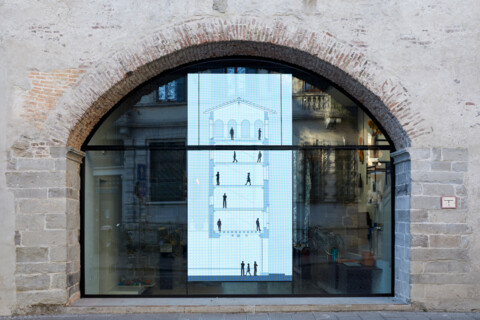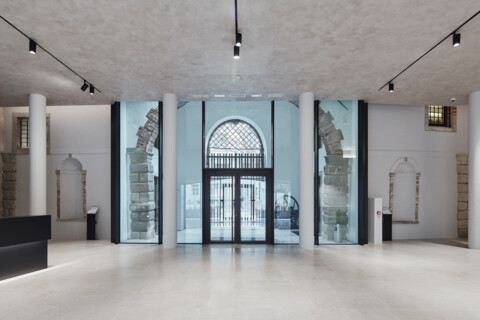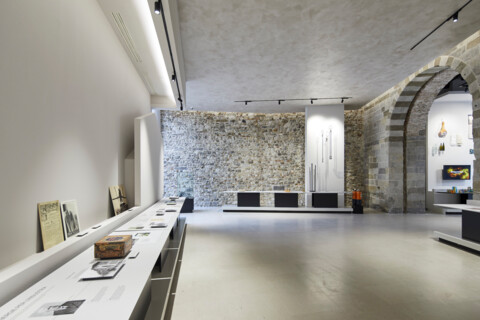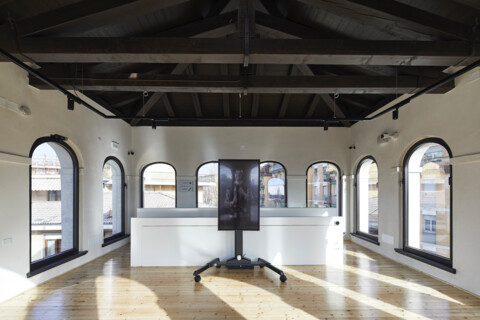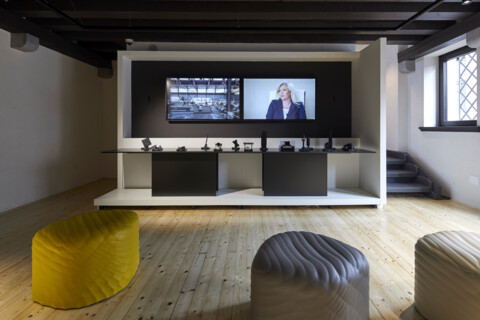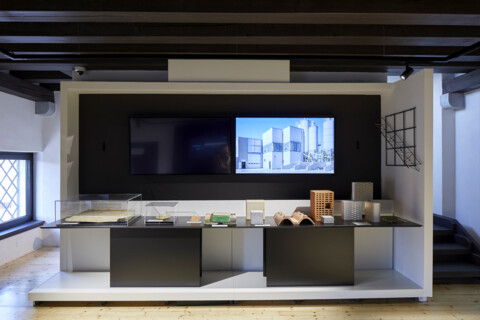Press release by The Architecture Curator for AV/S Alessandro Verona Studio
La Vetrina dell’Ingegno
AV/S Alessandro Verona Studio
“LA VETRINA DELL’INGEGNO” (NAMELY “THE SHOWCASE OF INGENUITY“) DESIGNED BY ARCHITECT ALESSANDRO VERONA REIMAGINES THE THIRTEENTH-CENTURY TOWER OF SANTA MARIA IN THE CITY OF UDINE, IN NORTHERN ITALY. THIS ICONIC STRUCTURE NOW SERVES AS MUSEUM, CHAMPIONED BY CONFINDUSTRIA, TO DOCUMENT THE RICH HISTORICAL LEGACY OF COMPANIES AND THE THRIVING BUSINESS CULTURE THAT DEFINES THE TERRITORY.
• AV/S Alessandro Verona Studio’s restoration and redevelopment project breathes new life into the thirteenth-century Tower of Santa Maria, an integral part of the magnificent architectural complex of Palazzo Torriani in Udine, in Northern Italy. This transformation transcends mere restoration, as the tower evolves into a device that - by seamlessly integrating memory and knowledge - channels the essence of local material culture and the remarkable ingenuity that has propelled its industry.
• The intervention establishes new connections between the city and the historic structure. The ancient arches are carefully restored, bringing them back to their original form. The notion of accessibility extends beyond the ground floor, encompassing all five levels of the tower. The external staircase gives way to a more efficient elevator, ensuring seamless mobility throughout the entire structure.
• Alessandro Verona’s project for “Lavetrina dell’Ingegno” (The Showcase of Ingenuity) effectively establishes a critical distance between historical memory and contemporary intervention. Similar to the new volume that extends the program on the ground floor, the structure of the new elevator serves as a contrasting element against the tower, taking the form of a sleek surface resembling an abstract blade, deliberately standing out from the solid mass of stone.
After a 15-year closure, the Santa Maria Tower in Udine has reopened its doors to the public, now housing “La vetrina dell’Ingegno,” a new museum complex dedicated to showcasing the rich history and unique industrial activities of this region in Northern Italy. The architectural project by AV/S Alessandro Verona Studio has successfully integrated new functional elements, which not only provide accessibility to the monumental structures but also establish a critical distance from the meticulously renovated existing features.
We find ourselves in the historic center of Udine, precisely along the fourth ring of walls, at a location of immense defensive importance for the city. The tower, initially constructed as a defensive structure and as a link between the interior and exterior of the city, has an intriguing history that spans various functions and purposes over the years. Originally utilized for defensive purposes, the tower eventually transformed into a private residence, made available for rent by the municipality. In more recent times, it served as a shop, an art studio, and in the 1980s, even as the “Museum of the City.”
It is here, in 2017, that Confindustria Udine, the owner of this historic structure, entrusted the architectural firm of Alessandro Verona with the task of restoring and renovating the Tower of Santa Maria. The tower is located at the intersection of Via dei Torriani to the north and Via Zanon to the east. The objective of the project was to transform the tower into the permanent headquarters of a new museum. AV/S Alessandro Verona Studio developed the design, and construction began in October 2020. La Vetrina dell’Ingegno was inaugurated in December 2022.
The project focused on two fundamental elements: the design of new spaces on the ground floor and the repurposing of the tower. A new building encloses the existing courtyard and allows for an increased surface area on the ground floor. This expansion facilitates the inclusion of a hall, a space for presentations and workshops, and an exhibition area. The restoration and adaptation of the tower aim to remove architectural barriers and provide access to all levels of the tower. This involves replacing the existing external staircase with a more functional elevator.
On the ground floor, the existing arches of the Tower have been restored to their original form and dimensions. The pedestals, fixtures, and grids installed in the 1990s have been removed to ensure visibility of the exhibition space from the street. The main entrance arch, located internally within the structure and providing direct access to the hall, is accentuated by a frame that extends the entrance compass. The Aurisina stone floor and a Venetian spatolato ceiling transform the space of the external courtyard into an interior. The relationship between the ceiling of the hall and the existing structures is resolved with a joint made of metal and frosted glass, allowing light to filter around the perimeter and accommodating the geometric differences between the new intervention and the historic building.
Only the vertical element adjacent to the tower, which houses the elevator, is visible from the outside of the new structure. The volume added on the ground floor is lower than the crenellations of the ancient existing wall and hence is not visible from the outside. Its roof, serving as an emergency exit in compliance with fire safety regulations, also functions as a terrace for events and provides a vantage point overlooking the garden of Palazzo Torriani and the beautiful exedra.
The rear garden elevation showcases a striking juxtaposition of contemporary design elements against the imposing gravity of the historic walls. With sleek lines and a lightweight structure, the new intervention creates a visually compelling contrast against the gravity of the historic walls. The entrance to the hall, accommodating the necessary installations for the new activities within its double thickness, is characterized by a structure that creates a transitional space between the old and the new, giving it an appearance of suspension. The pointed shape that emerges on the interior facade not only signifies the entrance to the hall but also creates a distinctive tympanum-like feature. This design reference draws inspiration from the architectural element overlooking the historic entrance, intentionally left exposed to maintain its historical significance.
“The project establishes a deliberate distance from the existing context, free from nostalgic sentiments.. Our objective was to spark a meaningful conversation between contemporary design and history. This dialogue is crafted through the interplay of shape and material, between what is new and what is old, without intermediaries,” says Alessandro Verona.
“La Vetrina dell’Ingegno” houses a permanent exhibition on the history of the Udine Industrial Association and a meeting space on the ground floor. Across the five floors of the tower, temporary exhibitions are set up, each dedicated to one of the eleven product sectors of Confindustria Udine. On the top floor of the tower, an installation accompanies the extraordinary new perspective offered to the city.
The exhibition design, inspired by the renowned Quaranta5 series by Gino Valle and Herbert Ohl, and drawn by Alessandro Verona himself, establishes a flexible system for showcasing exhibitions related to various product sectors that will unfold over time.
On the ground floor, in addition to a section dedicated to the history of Palazzo Torriani itself, there are presentations showcasing the history of Confindustria Udine and an introduction to the various product sectors. This section focuses on highlighting outstanding entrepreneurs. On the upper floors, through a carefully curated audiovisual documentation, an annual presentation is made to showcase industrial activities that align with the product sectors of Confindustria Udine. These presentations emphasize and celebrate the history and defining characteristics of industrial production activities in the local area and the city, which La Vetrina dell’Ingegno embraces.
Data and credits of the project
Name of the project
La Vetrina dell’Ingegno
Location
Udine, Italy
Client
Confindustria Udine
Architectural and exhibition design project
Alessandro Verona Studio
Design team
Alessandro Verona, Emanuele Crainich, Ilenia Iuri, Ana Paola Roca Vera
Structural engineering
Andrea Craighero
Mechanical engineering
ETA Progetti
Contractor
Cella Costruzioni
Subcontractors
Castellani Impianti
Gover Impianti Elettrici
Schedule
April 2017: project commission
October 2020: start of construction site / start of restoration and addition work
December 2022: opening
Data
Ground floor: 380 square meters (Entrance / Reception / History of the Tower of Santa Maria / Presentation of Confindustria Udine / Material/immaterial library of Confindustria)
First floor: 50 square meters (Temporary exhibition) + mq 320 (Walkable roof for events)
Second floor: 45 square meters (Temporary exhibition)
Third floor: 45 square meters (Temporary exhibition)
Fourth floor: 45 square meters (Temporary exhibition)
Fifth floor: 45 square meters (Temporary exhibition)
Suppliers
set-up: Fantoni
woodwork: Catarossi
visual communication: Art& Grafica pouf: Tonon
chairs: Linea Fabbrica
Technical set-ups
video: HDDS vision
audio: ESG elettronica
contents: Cooperativa Varianti (Paolo Comuzzi, Sabrina Tonutti)
graphics: Aipem
Photographer
Massimo Crivellari
Press office
The Architecture Curator
AV/S Alessandro Verona Studio
AV/S Alessandro Verona Studio specializes in urban redevelopment projects and the design of buildings for public administrations, businesses, and private entities. The architectural firm is led by Alessandro Verona, who graduated from IUAV in Venice in 1991 under the guidance of thesis advisors Vittorio Gregotti and Filippo Messina.
In both their projects and research, AV/S explores the relationship between program, form, and space, resulting in innovative designs that challenge the boundaries between interior and exterior. In recent years, the firm has placed particular emphasis on the significance of urban design in shaping new urban landscapes through a network of relationships.
When it comes to public spaces, especially squares, which traditionally serve as meeting points, AV/S has developed a distinctive design strategy that combines commercial enhancement with social inclusion. They achieve this by incorporating history and memory into their designs. AV/S has successfully implemented numerous interior design interventions where the interplay between materials and space creates unique and inviting atmospheres.
In addition to his professional work, Alessandro Verona has also engaged in cultural activities for over a decade. This parallel involvement has greatly influenced the realization of numerous projects, including the recenty completed La Vetrina dell’Ingegno.
-
AV/S Alessandro Verona Studio, La Vetrina dell’Ingegno. Photo: Massimo Crivellari.
-
AV/S Alessandro Verona Studio, La Vetrina dell’Ingegno. Photo: Massimo Crivellari.
-
AV/S Alessandro Verona Studio, La Vetrina dell’Ingegno. Photo: Massimo Crivellari.
-
AV/S Alessandro Verona Studio, La Vetrina dell’Ingegno. Photo: Massimo Crivellari.
-
AV/S Alessandro Verona Studio, La Vetrina dell’Ingegno. Photo: Massimo Crivellari.
-
AV/S Alessandro Verona Studio, La Vetrina dell’Ingegno. Photo: Massimo Crivellari.
-
AV/S Alessandro Verona Studio, La Vetrina dell’Ingegno. Photo: Massimo Crivellari.
-
AV/S Alessandro Verona Studio, La Vetrina dell’Ingegno. Photo: Massimo Crivellari.
-
AV/S Alessandro Verona Studio, La Vetrina dell’Ingegno. Photo: Massimo Crivellari.
-
La Vetrina dell’Ingegno
-
AV/S Alessandro Verona Studio, La Vetrina dell’Ingegno. Photo: Massimo Crivellari.
-
AV/S Alessandro Verona Studio, La Vetrina dell’Ingegno. Photo: Massimo Crivellari.
-
AV/S Alessandro Verona Studio, La Vetrina dell’Ingegno. Photo: Massimo Crivellari.
-
AV/S Alessandro Verona Studio, La Vetrina dell’Ingegno. Photo: Massimo Crivellari.
-
AV/S Alessandro Verona Studio, La Vetrina dell’Ingegno. Photo: Massimo Crivellari.
-
AV/S Alessandro Verona Studio, La Vetrina dell’Ingegno. Photo: Massimo Crivellari.
-
AV/S Alessandro Verona Studio, La Vetrina dell’Ingegno. Photo: Massimo Crivellari.
-
AV/S Alessandro Verona Studio, La Vetrina dell’Ingegno. Photo: Massimo Crivellari.
-
AV/S Alessandro Verona Studio, La Vetrina dell’Ingegno. Photo: Massimo Crivellari.
-
AV/S Alessandro Verona Studio, La Vetrina dell’Ingegno. Overview.
-
AV/S Alessandro Verona Studio, La Vetrina dell’Ingegno. Ground floor plan, existing.
-
AV/S Alessandro Verona Studio, La Vetrina dell’Ingegno. Ground floor plan, project.
-
AV/S Alessandro Verona Studio, La Vetrina dell’Ingegno. Ground floor plan, project.
-
AV/S Alessandro Verona Studio, La Vetrina dell’Ingegno. Mezzanine floor plan, project.
-
AV/S Alessandro Verona Studio, La Vetrina dell’Ingegno. First floor plan, project.
-
AV/S Alessandro Verona Studio, La Vetrina dell’Ingegno. Second floor plan, project.
-
AV/S Alessandro Verona Studio, La Vetrina dell’Ingegno. Third floor plan, project.
-
La Vetrina dell’Ingegno. Fourth floor plan, project.
-
AV/S Alessandro Verona Studio, La Vetrina dell’Ingegno. Fifth floor plan, project.
-
AV/S Alessandro Verona Studio, La Vetrina dell’Ingegno. East elevation.
-
AV/S Alessandro Verona Studio, La Vetrina dell’Ingegno. West elevation.
-
AV/S Alessandro Verona Studio, La Vetrina dell’Ingegno. Section AA’.
-
AV/S Alessandro Verona Studio, La Vetrina dell’Ingegno. Axonometric.
